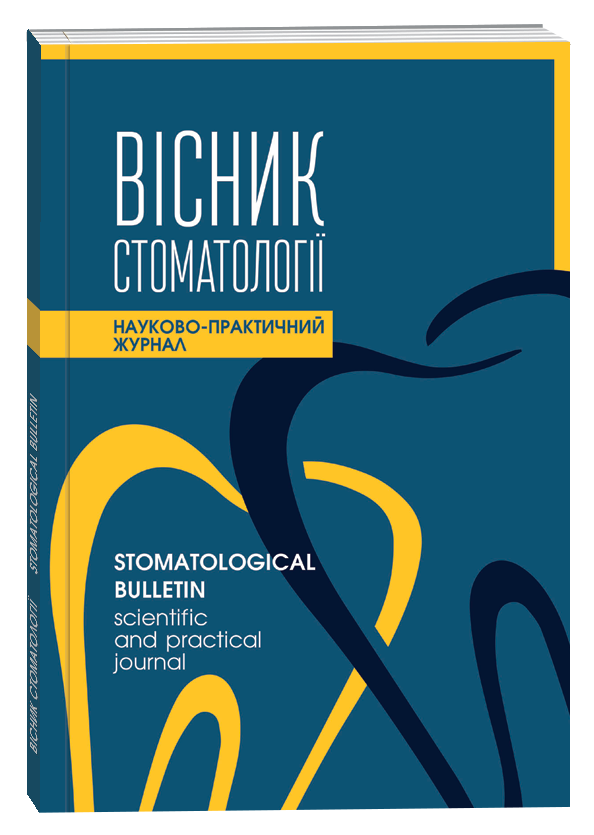USE OF FIXATORS MADE OF LOW MODULUS β-ZrTiNb ALLOY IN PATIENTS WITH TRAUMATIC FRACTURES OF THE LOWER JAW
DOI:
https://doi.org/10.35220/2078-8916-2023-49-3.12Keywords:
mandibular fractures, new alloys, low-modulus β-ZrTiNb alloy, osteosynthesis, miniplatesAbstract
Purpose of the study. To assess the effectiveness of clinical application of plates made from a new lowmodulus β-ZrTiNb alloy for treating lower jaw fractures in a prospective controlled study. Research materials and methods. The study included 53 patients with traumatic lower jaw fractures, divided into two groups matched by age, gender, and nature of the injury. In the first (experimental) group (26 patients), osteosynthesis was performed using plates made from the low-modulus β-Zr- Ti-Nb alloy. In the second (control) group (27 patients), fracture reduction and fixation were carried out using traditional titanium miniplates and screws. Both groups of patients were assessed for age, etiology of the injury, fracture localization, time to surgery, effectiveness of osteosynthesis, operative time, and postoperative complications. Statistical analysis included calculations of mean values, standard deviations, and standard errors of the mean. The significance of differences was determined using non-parametric Mann-Whitney and Pearson's chi-squared tests, with calculations performed using SPSS Statistics v.22 (IBM SPSS, USA). Results: Among all 53 patients with traumatic lower jaw fractures of various locations (a total of 95 fracture zones) included in the study, 94.3% (n=50) were male. The average age of patients was 38.5±13 years. The primary causes of injury were assaults (73.6 %) and falls (17 %). After osteosynthesis in the experimental group, anatomically accurate reduction (5 points) was observed in 21 patients (80.7 %), and 4 points were observed in 5 patients (19.2 %). In the control group, 5 points were observed in 22 patients (84.6 %), and 4 points were observed in 5 patients (18.5 %). The use of β-Zr-Ti-Nb alloy fixators resulted in a slight decrease in the frequency of inflammatory processes (11.5% in the experimental group vs. 15.4 % in the control group) and the development of neuropathies (3.8 % in the experimental group vs. 11.5 % in the control group). However, with this sample size, the differences were not statistically significant (p>0.05). No signs of side effects or toxicity were observed when using plates made from the β-Zr-Ti-Nb alloy. Conclusions: The obtained data indicate the potential for effective and safe use of new plates made from the β-Zr-Ti-Nb alloy for lower jaw osteosynthesis under immediate or early mobilization conditions.
References
Van Hout W. M., Van Cann E. M., Abbink J. H., Koole R. An epidemiological study of maxillofacial fractures requiring surgical treatment at a tertiary trauma centre between 2005 and 2010. The British journal of oral & maxillofacial surgery. 2013. № 51(5). Р. 416–420 https://doi.org/10.1016/j.bjoms.2012.11.002.
Manson P. N., Prein J., Ehrenfeld M. Principles Of Internal Fixation Of The Craniomaxillofacial Skeleton Trauma And Orthognathic Surgery. 2012. 412 р.
Allgöwer M., Müller M. E., Schneider R., Willenegger H. Manual of INTERNAL FIXATION. Springer Science & Business Media. 2013.
Chen Y. T., Chiu Y. W., Chang Y. C., Lin, C. W. Ten-year retrospective study on mandibular fractures in central Taiwan. The Journal of international medical research. 2020. № 48(7). 300060520915059. https://doi.org/10.1177/0300060520915059.
Hsieh T. Y., Funamura J. L., Dedhia R., Durbin-Johnson B., Dunbar C., Tollefson T. T. Risk Factors Associated With Complications After Treatment of Mandible Fractures. JAMA facial plastic surgery. 2019. № 21(3). Р. 213–220 https://doi.org/10.1001/jamafacial.2018.1836.
Niinomi M. Mechanical biocompatibilities of titanium alloys for biomedical applications. Journal of the mechanical behavior of biomedical materials. 2008. № 1(1). Р. 30–42 https://doi.org/10.1016/j.jmbbm.2007.07.001.
Moratal D. Finite element analysis. In Sciyo eBooks. 2010. https://doi.org/10.5772/281
Пат. 102455 UА, МПК А61L27/00. А61F2/02, C22C16/00, B82B3/00, Біосумісний сплав із низьким модулем пружності на основі системи цирконій-титан /О.М. Івасишин, І.М. Скиба, О.П. Красевська, П.Є. Марковський; Інститут металофізики імені Г.В. Курдюмова НАН України, опубл. 10.07.2013, Бюл. № 13.
Chenakin S., Mordyuk B., Khripta N. Surface composition, structure and corrosion properties of a ZrTiNb alloy: Effect of impact treatment energy. Vacuum. 2023. № 210. Р. 111889 https://doi.org/10.1016/j.vacuum.2023.111889.
Зеленська Н.В. Морфо-функціональні особливості кістки при введенні металевих імплантантів різного складу: дис. … канд. мед. наук : 14.03.01. Суми: СумДУ; Мед. ін-т, 2017. 163 с.
Юхимчук О.А., Калашніков А.В. Механічні властивості регенерату зони перелому стегнової кістки при застосуванні імплантатів із різним модулем пружності. Біль. Суглоби. Хребет. 2015. № 3 (19). С. 59-63.
Elsayed, S. A., Abdullah, A. A. B., Dar-Odeh, N., & Altaweel, A. A. (2021). Intraoral Wound Dehiscence After Open Reduction Internal Fixation of Mandibular Fractures: A Retrospective Cohort Study. Wounds: a compendium of clinical research and practice, 33(3), 60–64.
Копчак А.В., Скиба І.А., Крищук М.Г., Романова А.Ю., Іщенко О.А. Особливості напружено-деформованого стану системи фіксатор-кістка при остеосинтезі нижньої щелепи пластинами з β-Zr-Ti-Nb сплаву. Літопис травматології та Ортопедії. 2016. № 1, С. 75-82.
Копчак А.В. Хірургічна тактика лікування хворих з травматичними переломами нижньої щелепи. Хірургія України. 2014. № 2. С. 31-37.
Гельсінкська декларація Всесвітньої медичної асоціації. "Етичні принципи для медичних досліджень із залученням людини". Український вісник психоневрології. 2008. № 16(3). С. 70-2.
Про охорону здоров'я: Закон України віл 19.11.1992 No2801-XII. Відомості Верховної Ради України (ВВР). 1993. (4). С. 19.
Копчак, А. В. Порівняльна оцінка способів остеосинтезу виросткового відростку нижньої щелепи при його травматичних переломах. Acta Medica Leopoliensia 20. 2014. № 2. С. 9–17.
Wei C., Luo L., Wu Z., Zhang J., Su S., Zhan Y. New Zr-25Ti-xMo alloys for dental implant application: Properties characterization and surface analysis. Journal of the mechanical behavior of biomedical materials. 2020. № 111. Р. 104017 https://doi.org/10.1016/j.jmbbm.2020.104017.
Katti K. S. Biomaterials in total joint replacement. Colloids and surfaces. B, Biointerfaces. 2004. № 39(3). Р. 133–142 https://doi.org/10.1016/j.colsurfb.2003.12.002.
Bormann K. H., Gellrich N. C., Kniha H., Dard M., Wieland M., Gahlert M. Biomechanical evaluation of a microstructured zirconia implant by a removal torque comparison with a standard Ti-SLA implant. Clinical oral implants research. (2012). № 23(10). Р. 1210–1216. https://doi.org/10.1111/j.1600-0501.2011.02291.x
Міщенко О.М., Солодовник О.В., Олешко О.М. Остеоінтеграція дентальних імплантатів з різними типами поверхні. Буковинський медичний вісник. 2020. № 1. С. 79-89.









